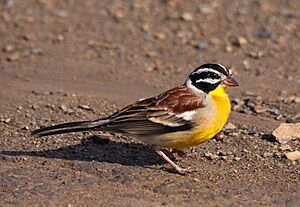Golden-breasted bunting facts for kids
Quick facts for kids Golden-breasted bunting |
|
|---|---|
 |
|
| The nominate subspecies in Hluhluwe-Umfolozi Game Reserve, South Africa | |
| Conservation status | |
| Scientific classification |
The golden-breasted bunting (Emberiza flaviventris) is a small, colorful passerine bird. It belongs to the bunting family, Emberizidae. You can find this bird in Africa, south of the Sahara Desert. It lives in dry open woodlands and moist savannas. However, it does not live in the thick forests near the equator.
Contents
What Does It Look Like?
The golden-breasted bunting is about 15 to 16 centimeters long. That's about the length of a pen!
Male and Female Birds
Adult male buntings have a very striking head. They have a white crown on top of their head. There are black stripes on the sides of the crown. They also have a white stripe above their eye, called a supercilium. Their cheeks are white with black borders.
The bird's belly is orange-yellow. This color becomes yellow on its throat and whitish lower down. Its back is chestnut brown, and its rump (the area above its tail) is grey. Its wings are browner and have two clear white bars.
Male and female golden-breasted buntings look very similar. However, females might have a slightly buff (pale yellowish-brown) color on their white head markings. Their head stripes can also be browner. Sometimes, their back might have dark streaks.
Young Birds
Young golden-breasted buntings are not as brightly colored as the adults. They are duller and paler than the females.
Different Types of Golden-breasted Buntings
There are three main types, or subspecies, of the golden-breasted bunting:
- E. f. flaviventris: This type lives from the Cape in South Africa up to southern South Sudan.
- E. f. flavigaster: This type lives in a narrow strip across the Sahel region. Its home range is separate from the other types.
- E. f. princeps: This type lives in southern Angola and Namibia.
The E. f. princeps type looks a lot like the flaviventris type. But it is larger and has paler colors on its belly. The E. f. flavigaster type is more unique. It has a paler, redder back. Its rump is pale grey, and its belly is a paler yellow. Its sides are whiter.
Where Do They Live?
These birds live in many kinds of open woodlands. The flavigaster type prefers acacia trees in steppes and savannas. The other types live in a wider range of lightly wooded areas, including gardens.
How Do They Behave?
The golden-breasted bunting makes a nasal, rising sound like zzhrr. Its song can change, but it often includes a weechee weechee weechee sound.
Nesting and Life Cycle
The golden-breasted bunting builds a somewhat messy cup nest. It lines the nest with fine grass or hair. They usually build their nests low in a shrub or a young tree.
The female lays two or three eggs. The eggs are shiny white or cream-colored and have black lines on them. The eggs hatch in about 12 to 13 days. The young chicks then stay in the nest for another 16 to 17 days before they are ready to fly.
Feeding Habits
Golden-breasted buntings usually do not live in large groups. You will often see them alone, in pairs, or in small groups. They look for food on the ground. They eat seeds, insects, and spiders. They mostly eat insects and spiders when they have young chicks to feed.
These birds generally stay in one area. However, they might move around a bit locally. They are often quite calm and not easily scared by people.



